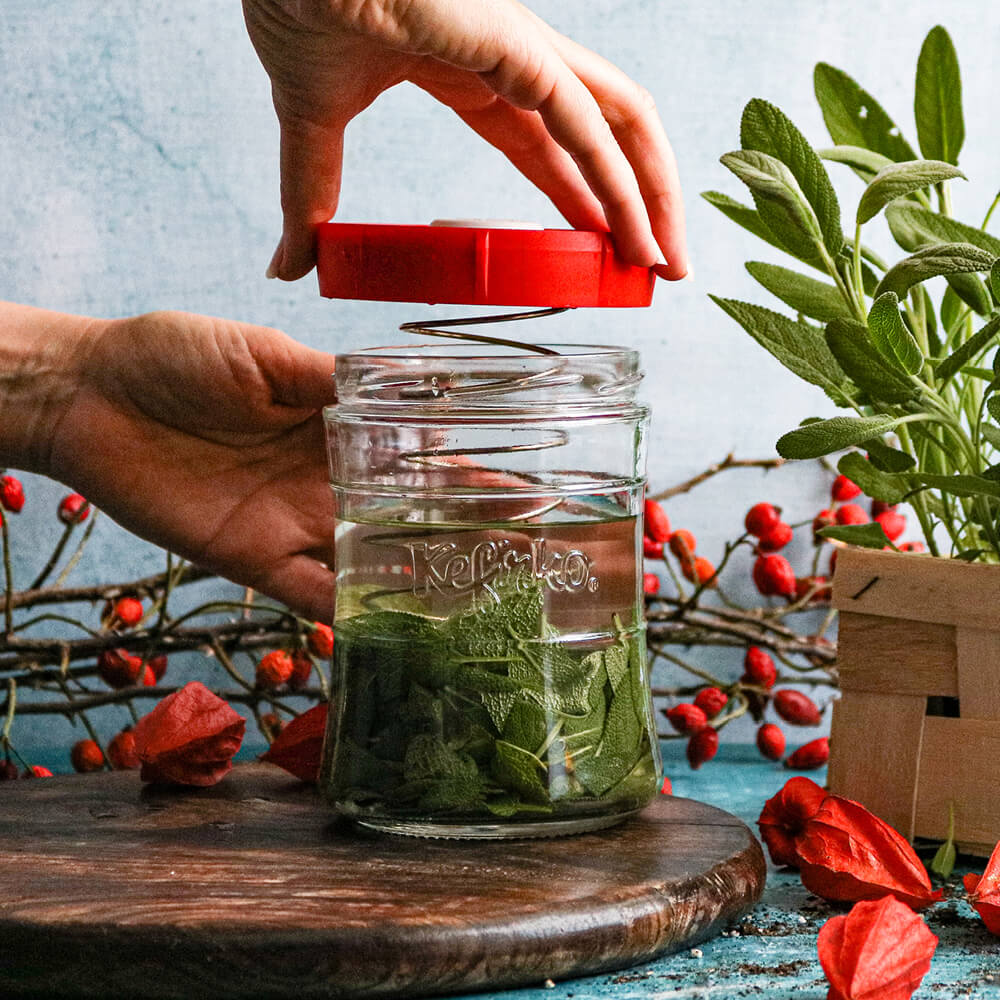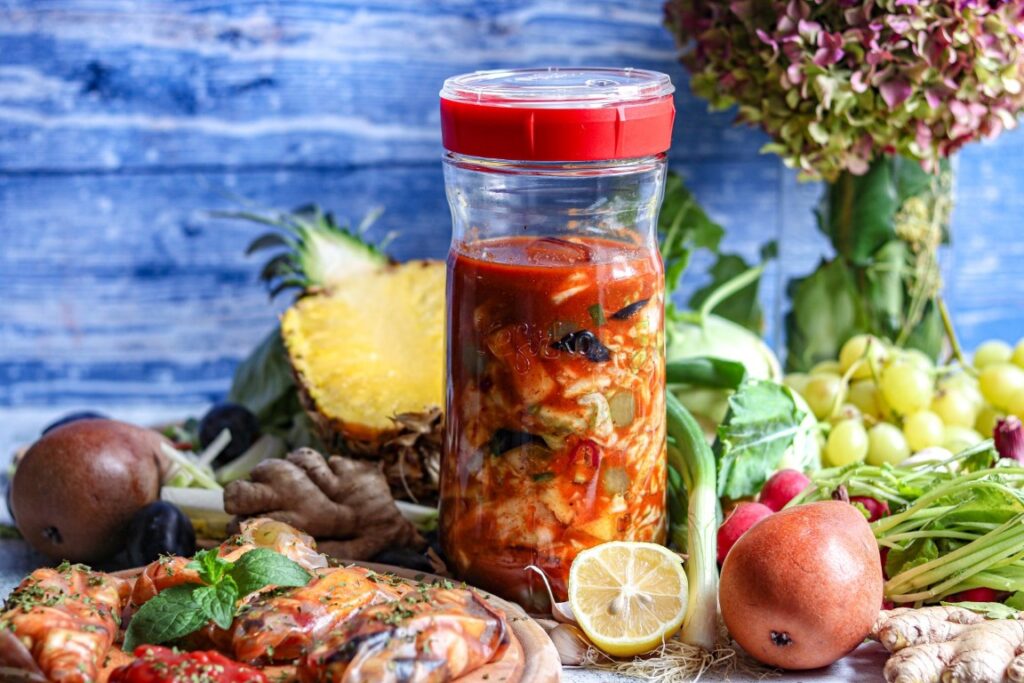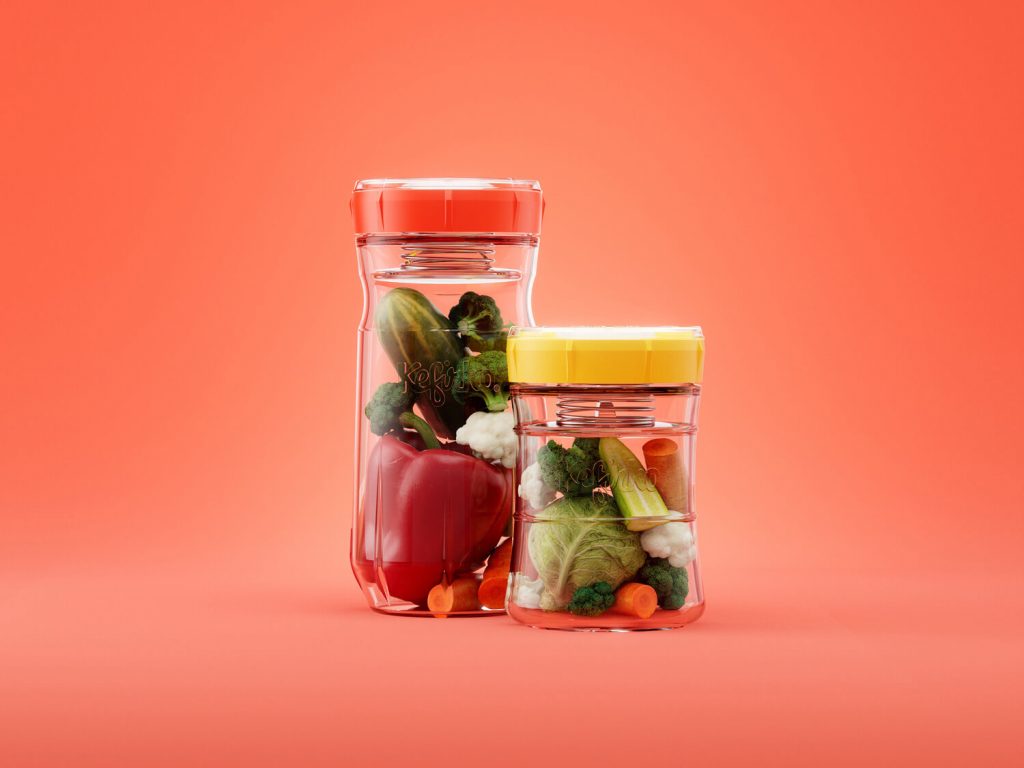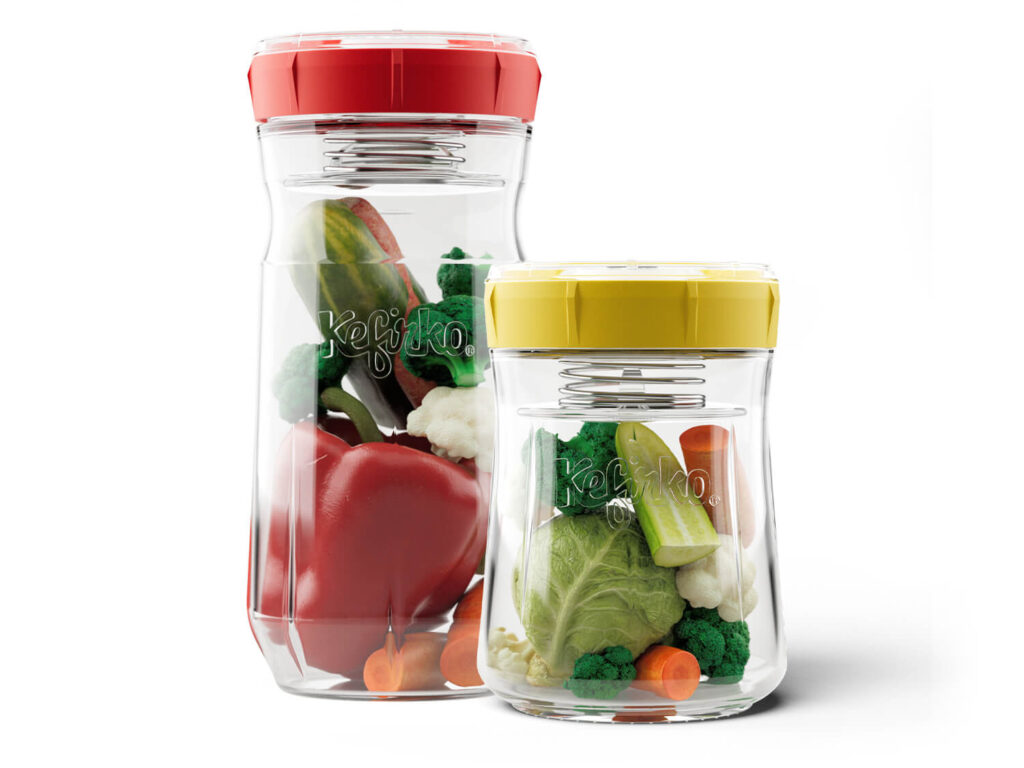FERMENTING VEGETABLES & FRUITS
Ferment mixed veggies, kimchi, sauerkraut, fruits or any other vegetable in your kitchen!

FERMENTING VEGETABLES AND FRUITS
Fermented vegetables are full of positive microorganisms, nutrients and are absorbed more easily than fresh ones. Regular consumption of fermented food may have positive effects on gut health, managing cholesterol level, strengthening immune system, regulating appetite, weight loss and many more.
Fermentation is a natural preservation method.

It can be quite simple
Ferment mixed vegetables, kimchi, sauerkraut,
fruits or vegetables in your kitchen!

1. Prepare ingredients

2. Add glass weight

3. Leave to ferment
For the basis of fermentation, you need vegetables or fruit, a 2% brine, and an airtight jar.
During fermentation, the vegetables must be covered with liquid – weights and a spring can greatly simplify the process and ensure safety.
The difference between fermentation and pickling
Fermentation is a natural souring process where beneficial bacteria produce lactic acid, preserving the vegetables and enriching them with probiotics. Pickling in vinegar, on the other hand, uses added vinegar to create an acidic pH that prevents the growth of microorganisms and preserves the food, but without probiotic value.
See answers to the FAQ about fermenting vegetables and fruits below.
FERMENTING VEGETABLES AND FRUITS
How to
What You Need to Start Fermenting Vegetables
To successfully ferment vegetables at home, it’s essential to follow a few simple guidelines:- Use Non-Metal Equipment: Always choose non-reactive tools such as glass jars, wooden spoons, and plastic or silicone lids. Metal can interfere with the fermentation process and affect taste and safety.
- Salt and Brine: Salt is crucial for fermentation. A 2% salt solution is the standard ratio. You can either:
- Mix the salt directly with chopped vegetables, or
- Dissolve salt in water to create a brine and pour it over whole or cut vegetables.
- Keep Produce Submerged: Ensure all vegetables are fully submerged in the brine to prevent exposure to air. Oxygen can lead to mold and spoilage.
- Maintain Hygiene: Clean hands, tools, and containers are vital. Sterilized jars help ensure a safe fermentation environment.
BASIC RECIPE FOR FERMENTED VEGETABLES
Ingredients:- Fresh vegetables or fruits (chopped or whole)
- 2% salt by weight (e.g., 20g salt per 1 liter of water)
- Filtered water (chlorine-free)
- Clean glass jar with airtight or fermentation-safe lid
- Wash and prepare your vegetables.
- Dissolve salt in water to make the brine.
- Place vegetables in the jar and pour the brine over them.
- Use a weight to keep the produce submerged.
- Seal the jar and store it in a cool, dark place for several days to a few weeks, depending on taste and room temperature.
Vegetables and fruits contain all the necessary microorganisms for the fermentation. When you’re not sure about this or want to make it faster and more consistent, you can use some help in the shape of starter cultures. This is usually a powdered culture that you mix in the brine. You can get help with whey that is also full of microorganisms, some people like to use sauerkraut juice from the previous batch for the new fermentation. Some even use the extra kefir grains and add them in a mix. All these options are available, but don’t be afraid of the wild fermentation that happens naturally, with great ingredients and a little bit of salt.
Other / Troubleshooting
You can ferment almost all vegetables and even some fruits – apples, berries. Cabbage is one of the most popular vegetables to ferment and next in line are radishes. You can ferment garlic, cucumbers, carrots, celery, green beans and even herbs. There are some limitations with green leafy vegetables because of their distinctive taste that becomes even stronger with fermentation. With a little bit of experience you can ferment almost everything.
Veggie Fermenter
Salt is important to create the environment where Lactobacillus bacteria will thrive, while yeast and molds will not be able to form and this will protect your ferment.
The percentage of salt is calculated for the total weight of your ingredients and water. It is recommended to use about 2% brine. So, for 1kg of ingredients this means about 20g salt. But keep in mind that fermentation is faster when the temperature is higher. So, in warmer seasons you may add more salt to slow down the fermentation.
Many bacteria and yeasts in your ferment are doing their job which produces gas. If you are new to this it may come as a shock but it does not mean the ferment has gone bad. The Veggie Fermenter has an active carbon filter that reduces the smell of the gases coming from the jar.
Mold is the most common problem when fermenting vegetables. This is usually because the ferment was in contact with air. Some people just remove the layer with mold, but to be on the safe side it’s best to discard the whole jar in this case. You can prevent mold growth by keeping the ferment submerged at all times.
Most vegetables change color slightly due to fermentation. Color usually fades. If they are very dark before fermenting they may color the other vegetables in the jar. For instance the beet root or purple cabbage may color the whole jar in pink. If you notice pink color even if there are no vegetables of this color in the jar that may be a contamination and you need to discard the whole jar. Dark layers of vegetables in the jar usually mean that the vegetables were not covered in brine and came in contact with air.
Once fermentation is finished you can store the vegetables or fruits in the fridge. Freezing is acceptable too but low temperatures may kill some of the beneficial microorganisms. It’s best to store them in glass jars with a lid and to make sure they are covered in brine all the time. Plastic containers are not recommended as much because the ferments are usually acidic which may affect the plastic.
It’s important to ensure that the fermented food is safe to eat before consuming it.
Here are some tips:
- Check for signs of spoilage: If you notice any off smells or flavors, mold, or signs of spoilage such as discoloration or sliminess, discard the ferment immediately.
- Look for bubbles: During fermentation, carbon dioxide is produced, which creates bubbles in the ferment. If you don’t see any bubbles, it may indicate that the fermentation process has not occurred or that it’s incomplete.
- Check the pH: Fermented foods should have a pH level of 4.6 or lower to prevent the growth of harmful bacteria. You can use a pH meter or pH test strips to check the acidity of your ferment.
- Taste a small amount: If you’re unsure about the safety of your ferment, taste a small amount to see if it has a pleasant flavor.
- Use proper fermentation techniques: To ensure that your ferment is safe to eat, follow proper fermentation techniques such as using clean equipment, using the right amount of salt or starter culture, and fermenting at the correct temperature and time.
RECIPES
How to
Why Ferment Vegetables?
Fermenting vegetables is a time-honored method of preserving fresh produce, capturing both flavor and nutrients at their peak. This natural preservation technique not only extends shelf life but also promotes gut health through the development of beneficial probiotics.
When vegetables are in season and abundant, fermentation is one of the best ways to avoid waste and enjoy their benefits year-round. This process enhances the taste, texture, and nutritional value of your favorite produce.
How to make kimchi?
Learn how to make delicious, probiotic-rich kimchi at home with this easy step-by-step guide! Ferment your own kimchi naturally and boost your gut health with this flavorful, traditional Korean dish.
Kimchi Recipe Steps:
- Prepare a 2% salt brine
- Submerge vegetables for 8–12 hours
- Chop vegetables
- Season with salt and kimchi paste
- Press tightly into a fermentation jar
- Let ferment at room temperature for 3–4 days
How to make sauerkraut?
Learn how to make your own probiotic-rich sauerkraut with just cabbage and salt! This quick tutorial shows how to ferment sauerkraut using simple tools like a glass jar, weight, and spring for perfect results.
Sauerkraut Recipe:
- Chop fresh cabbage
- Add 2% salt (based on cabbage weight)
- Press into a glass jar
- Use a glass weight and pressing spring
- Pump out air, seal the jar, and let ferment at room temperature for up to 2 weeks
Great for gut health, easy to make, and full of flavor!




